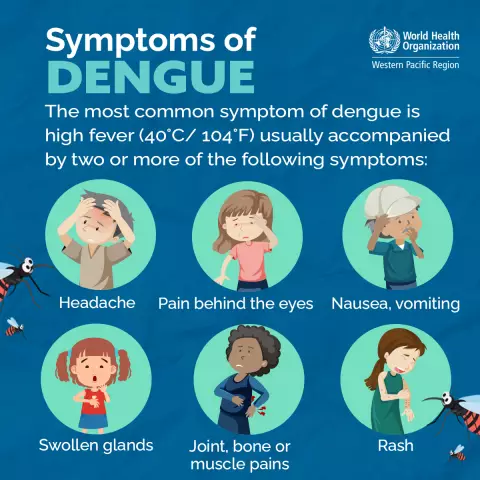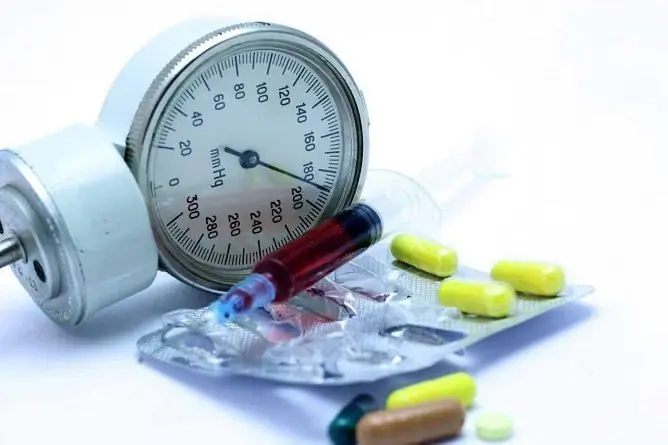- Author Rachel Wainwright [email protected].
- Public 2023-12-15 07:39.
- Last modified 2025-11-02 20:14.
13 causes of low-grade fever
Subfebrile is called an elevated body temperature up to 38 ° C, and subfebrile is the presence of such a temperature for more than 3 days, and often for no apparent reason. Subfebrile condition is a clear sign of disorders in the body that arise due to illness, stress, hormonal disruptions. Despite the seeming harmlessness, this condition, in which people often continue to lead their usual lifestyle, can turn out to be a symptom of a disease, including a serious one, and give undesirable consequences for health. Let's consider 12 main reasons that cause an increase in body temperature to subfebrile values.
Acute infectious diseases
The inflammatory process caused by infectious diseases (ARVI, pneumonia, bronchitis, tonsillitis, sinusitis, otitis media, pharyngitis, etc.) is the most common cause of low-grade fever, and it is this that doctors tend to suspect in the first place when they complain about temperature. The peculiarity of hyperthermia in diseases of an infectious nature is that the general state of health also worsens (headache, weakness, chills occur), and when taking an antipyretic agent, it quickly becomes easier.

Source: depositphotos.com
Low-grade fever in children occurs with chickenpox, rubella and other childhood diseases in the prodromal period (that is, before the appearance of other clinical signs) and during the recession of the disease.
Chronic nonspecific infections
Infectious subfebrile condition is also inherent in some chronic pathologies (often during an exacerbation):
- diseases of the gastrointestinal tract (pancreatitis, colitis, gastritis, cholecystitis);
- inflammation of the urinary tract (urethritis, pyelonephritis, cystitis);
- inflammatory diseases of the genital organs (prostate, uterine appendages);
- non-healing ulcers in the elderly and patients with diabetes mellitus.
To identify sluggish infections, therapists, as a rule, use a general urine test, and if inflammation in a specific organ is suspected, an ultrasound scan, an X-ray and an examination by an appropriate specialist are prescribed.

Source: depositphotos.com
Toxoplasmosis
Low-grade fever is often a symptom of toxoplasmosis, a parasitic disease that can be transmitted from cats. Also, food products (meat, eggs) that have not undergone sufficient temperature processing become a source of infection. Toxoplasmosis in people with stable immunity proceeds imperceptibly, in a subclinical form, expressed in weakness, headache, impaired appetite and, in particular, subfebrile condition, which cannot be stopped by conventional antipyretic drugs. Recovery from toxoplasmosis in healthy people (without immunodeficiency), as a rule, occurs without any medication, however, in the case of an acute form of the disease that occurs with damage to internal organs, the pathology is eliminated with medication.

Source: depositphotos.com
Tuberculosis
Tuberculosis is a severe infection that affects the lungs, as well as urinary, bone, reproductive systems, eyes and skin. Low-grade fever, along with high fatigue, decreased appetite, insomnia, can be a sign of tuberculosis of any localization. The pulmonary form of the disease is determined by fluorography in adults and Mantoux test in children, which makes it possible to identify the disease at an early stage. Diagnosis of the extrapulmonary form is often complicated by the fact that tuberculosis is difficult to distinguish from other inflammatory processes in the organs, but in this case it is recommended to pay attention to the totality of symptoms characteristic of the disease: hyperthermia in the evenings, excessive sweating, and a sharp weight loss.

Source: depositphotos.com
HIV infection
A body temperature of 37-38 ° C together with pain in joints, muscles, rash, swollen lymph nodes can be a sign of an acute period of HIV infection that damages the immune system. The disease, incurable at the moment, makes the body defenseless against any infections - even those harmless (not fatal) such as candidiasis, herpes, ARVI. The latent (asymptomatic) period of HIV can last up to several years, however, as the virus destroys the cells of the immune system, the symptoms of the disease begin to appear in the form of candidiasis, herpes, frequent colds, stool disorders - and low-grade fever. Timely detection of HIV will allow the carrier to monitor his immune status and, using antiviral treatment, reduce the level of the virus in the blood to a minimum, preventing life-threatening complications.

Source: depositphotos.com
Malignant tumors
With the development of some tumor diseases in the body (monocytic leukemia, lymphoma, kidney cancer, etc.), endogenous pyrogens, proteins that cause an increase in body temperature, are released into the blood. Fever in this case is difficult to treat with antipyretics and is sometimes combined with paraneoplastic syndromes on the skin - acanthosis nigricans of the body folds (with cancer of the breast, digestive organs, ovaries), Daria erythema (with breast and stomach cancer), as well as itching without a rash and any other reasons.

Source: depositphotos.com
Viral hepatitis B and C
Fever in hepatitis B and C is a consequence of the intoxication of the body caused by damage to liver cells. Low-grade fever is often a sign of a sluggish form of the disease. In the initial stage, hepatitis is also accompanied by malaise, weakness, pain in joints and muscles, yellowness of the skin, and discomfort in the liver after eating. Early detection of such an intractable disease will help to avoid its transition to the chronic stage, and therefore, to reduce the risk of complications - cirrhosis or liver cancer.

Source: depositphotos.com
Helminthiasis (helminthic invasion)
A slight rise in temperature along with increased fatigue and weakness are signs of parasitic infections. Subfebrile condition arises due to the intoxication of the body with the waste products of worms and can be combined with digestive disorders, flatulence, drowsiness, emaciation (especially in the elderly and children). In advanced cases, helminthiasis causes severe ailments, up to intestinal obstruction, biliary dyskinesia, damage to the kidneys, liver, eyes, brain, therefore it is important to identify the disease at an early stage. As a rule, one or two courses of anthelmintic drugs are sufficient for a complete recovery.

Source: depositphotos.com
Diseases of the thyroid gland
An increase in body temperature as a result of an acceleration of metabolism in the body also occurs with hyperthyroidism, a disorder associated with increased production of thyroid hormones. A body temperature of at least 37.3 ° C with an ailment is accompanied by excessive sweating, inability to tolerate heat, thinning hair, as well as increased anxiety, tearfulness, nervousness, absent-mindedness. Severe forms of hyperthyroidism can lead to disability and even death, therefore, with the above symptoms, it is better to see a doctor and be examined. Antithyroid drugs and healing methods will help normalize the thyroid gland: hardening, diet therapy, moderate physical activity, yoga. In some cases, surgery may be required.

Source: depositphotos.com
Iron-deficiency anemia
Iron deficiency anemia, which can be caused by poor nutrition, chronic bleeding, diseases of the gastrointestinal tract, pregnancy, is an ailment that is often accompanied by subfebrile body temperature. In addition, diseases are accompanied by dizziness, thinning of hair, nails, dry skin, drowsiness, decreased immunity, and loss of strength. The lack of iron in the blood can usually be corrected within 2-3 months of treatment, but you should be aware that anemia can be an indicator of serious medical problems.

Source: depositphotos.com
Autoimmune diseases
Autoimmune diseases are diseases in which the immune system stops recognizing the body's own cells, identifying them as foreign and attacking. Due to the accompanying tissue inflammation and subfebrile body temperature occurs. Diseases of an autoimmune nature are different in localization and clinical manifestations, since it is not individual organs that are destroyed, but tissues, especially often connective tissue. The most common are rheumatoid arthritis, systemic lupus erythematosus, Crohn's disease. With an established diagnosis, it is necessary to immediately begin immunosuppressive therapy, since chronic diseases often lead to various disorders of the internal organs and severe complications.

Source: depositphotos.com
Psychogenic causes
Subfebrile condition, in fact, is a manifestation of an excessively fast metabolism, which is also influenced by the psyche. Stress, neuroses, strong emotional experiences, especially in people suffering from hypochondria, can lead to an increase in body temperature. For the diagnosis of psychogenic abnormalities, special questionnaires have been created (hospital scale of depression and anxiety, scale of emotional excitability, Beck scale), which make it possible to test for mental stability. When the diagnosis is confirmed, the patient is offered psychotherapeutic assistance, and also prescribed to take sedatives.

Source: depositphotos.com
Medicinal subfebrile condition
In some cases, a fever can be caused by prolonged drug therapy. The ability to raise the temperature to subfebrile values is possessed by thyroxin preparations, antibiotics (ampicillin, lincomycin, penicillin), antipsychotics, some antidepressants, antiparkinsonian and antihistamines, as well as narcotic pain relievers. To eliminate subfebrile temperature, cancel or replace the drug that caused this reaction.

Source: depositphotos.com
YouTube video related to the article:

Maria Kulkes Medical journalist About the author
Education: First Moscow State Medical University named after I. M. Sechenov, specialty "General Medicine".
Found a mistake in the text? Select it and press Ctrl + Enter.






